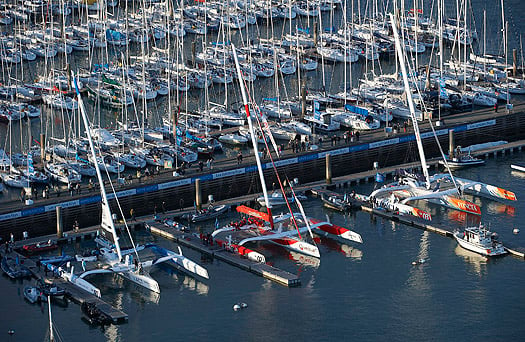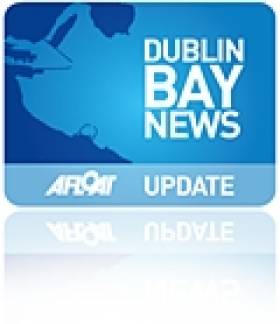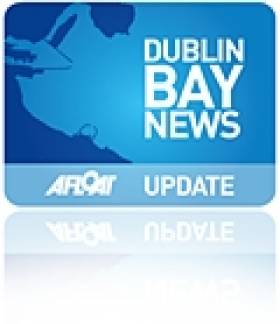Displaying items by tag: European Tour
MOD70 European Tour Comes to Dun Laoghaire Next Month
#DUN LAOGHAIRE NEWS - Dun Laoghaire will play host to sailing’s most exciting new global championship series when the MOD70 European Tour visits from Wednesday 5 to Sunday 9 September.
Ireland has hosted many of the world’s top sailing events during 2012 and the welcoming of this new series surely positions Ireland as one of the best sailing locations in the world. The MOD70 fleet - Race For Water, FONCIA, Groupe Edmond de Rothschild, Spindrift Racing and Musandam-Oman Sail - will be hosted by the National Yacht Club (NYC) and the Dun Laoghaire Harbour Company (DLHC), and a five-day family festival will be held on the East Pier to celebrate the arrival of the most innovative racing trimarans in the world.
The festival will include food courts, a farmers' market, Fairtrade and ethnic stalls, craft stalls, street entertainers and vintage amusements.
On Friday 7 September and Saturday 8 September the MOD70s will be competing in Dublin Bay in the Dublin City Race and Speed Match Races, and there will be live commentary from the East Pier. The trimarans will then leave Dun Laoghaire at 3pm on Sunday 9 September for the start of the second leg of the European Tour from Dun Laoghaire to Cascais.
Gerry Dunne, CEO of the DLHC, said: "We are delighted to welcome the world’s most innovative trimarans to Dun Laoghaire Harbour which has witnessed 200 years of maritime history. 1.4 million people walk the East Pier on an annual basis and we hope that the hosting of this global event will attract many more people to our beautiful harbour in September."
The high-speed MOD70 class of trimarans are a new innovation for sailing, and have already proven to be the fastest offshore one-design class in the world. Each MOD70 is completely identical, built from the same moulds, so that success – both inshore and offshore – reflects the skills of the sailing crew and not any technological advantage.
"The National Yacht Club has played host to many world championships and in July this year we co-hosted the ISAF Youth World Championships. We are delighted that the MOD70s has chosen Dun Laoghaire to host a stopover on the European Tour and we look forward to thousands of people visiting Dun Laoghaire to enjoy the spectacle," said Paul Barrington, Commodore of the NYC.
The MOD70 European Tour starts in Kiel, Germany before visiting Dublin, Cascais near Lisbon and Marseille before finishing in Genoa, Italy. Over the five weeks of the MOD70 European Tour the teams will sail nearly 5,000 miles over five offshore stages.
The tour is the second event of the Multi One Championship, following on from July’s inaugural Krys Ocean Race which saw the MOD70s race the Atlantic from New York to Brest in France at remarkable speeds. The first three boats finished within less than two hours after traversing the Atlantic in less than five days, with the winning boat making more than 711 miles in one 24-hour period.
Already the MOD70 fleet has attracted a cross-section of some of the best ocean racing sailors in the world. Michel Desjoyeaux of France has twice won the Vendée Globe solo round the world race and skippers FONCIA. There are more than eight sailors across the different boats who hold round the world records including Britain’s Brian Thompson who sails for Musandam-Oman Sail.
Thompson has more than 20 offshore sailing speed records to his name and was the only Briton on board Banque Populaire V when the giant multihull set a new record for sailing non-stop around the world in January.
Marco Simeoni, president of MOD SA, said of Dun Laoghaire's hosting of the tour: "Local knowledge and local expertise in hosting world-class sailing events is widely appreciated. We thank all the institutions involved in this stopover and we look forward to spending five wonderful days in the heart of the local culture. Sports and entertainment is guaranteed in the Dublin Bay from 5-9 September!"
Programme of events
Wednesday 5/Thursday 6 September
- All day Wednesday: Estimated arrival of MOD70s
- 10am–6pm: Food courts, farmers market, Fairtrade and ethnic stalls, craft stalls, family entertainment, vintage amusements (every day)
Friday 7 September
- 2pm: Dublin City Races and Speed Matches Day 1 (vantage points from the East Pier to Sandycove with live commentary from the East Pier)
- 10pm: Firework display in Dun Laoghaire Harbour
Saturday 8 September
- 2pm: Dublin City Races and Speed Matches Day 2
Sunday 9 September
- 3pm: Start of Leg 2 from Dublin (Dun Laoghaire) to Cascais (vantage points from the East Pier to Sandycove with live commentary from the East Pier)
Dun Laoghaire Earmarked For Stop on First MOD70 Euro Tour
#DUBLIN BAY NEWS - The inaugural European Tour for the MOD70 trimaran class is set to come to Dublin next summer, pending agreement with the relative authorities in January.
The Irish Times reports that the National Yacht Club is at the head of efforts to include an event in Dun Laoghaire on the first tour for the new 70-foot design.
But apart from the Dun Laoghaire Harbour Company, there has so far been little support from local or national authorities despite organisers waiving the €250,000 franchise fee.
John McKenna of tour organiser OC Thirdpole says he is determined to ensure Dublin is included, and that costs will be borne by the competing teams.
However, he added: "The tour needs to be assured that it will have a major public occasion in Dublin if it is to commit to coming here."

The MOD 70 fleet – plans are afoot to bring the fleet to Dun Laoghaire and moor them off the National Yacht Club at the Carlisle Pier
As previously reported on Afloat.ie, Dublin Bay welcomed its first MOD70 earlier this year when yachtsman Roland Jourdain tested his Veolia Environnement trimaran ahead of the Fastnet Race.
The Irish Times has more on the story HERE.






























































